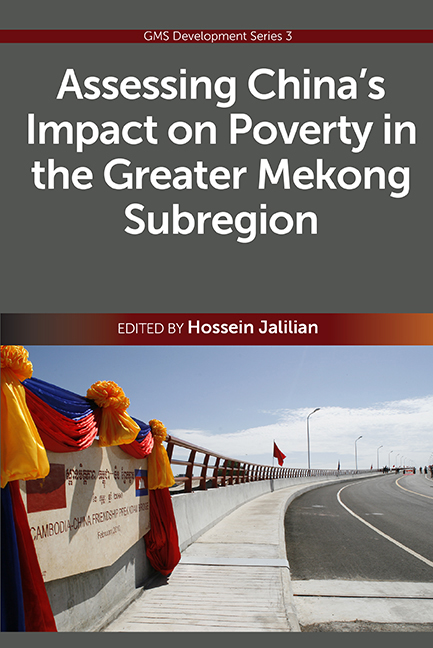Book contents
- Frontmatter
- Contents
- List of Figures, Tables and Boxes
- Foreword
- List of Contributors
- PART I The Context
- PART II CHINA AND THE GMS-4
- PART III THE GMS-4 AND CHINA
- 5 Impacts of China on Poverty Reduction in Vietnam
- 6 Impacts of China on Poverty Reduction in Thailand
- 7 Impacts of China on Poverty Reduction in Cambodia
- 8 Impacts of China on Poverty Reduction in Laos
- Index
8 - Impacts of China on Poverty Reduction in Laos
from PART III - THE GMS-4 AND CHINA
Published online by Cambridge University Press: 21 October 2015
- Frontmatter
- Contents
- List of Figures, Tables and Boxes
- Foreword
- List of Contributors
- PART I The Context
- PART II CHINA AND THE GMS-4
- PART III THE GMS-4 AND CHINA
- 5 Impacts of China on Poverty Reduction in Vietnam
- 6 Impacts of China on Poverty Reduction in Thailand
- 7 Impacts of China on Poverty Reduction in Cambodia
- 8 Impacts of China on Poverty Reduction in Laos
- Index
Summary
INTRODUCTION
China's rapid economic growth has increasingly attracted the attention of scholars and policy-makers around the globe. There has been much discussion as to the potential impacts of China's rise on the world economy and on the economies of developing countries in particular. In this vein there have been a number of publications and research works related to China's trade, investment and overseas development assistance (ODA) flow in the Greater Mekong Subregion (GMS) (for example, Jenkins and Edwards 2004). However, so far most studies have only provided general overviews and data on China's trade, investment and ODA and lack in-depth analysis on how trade with China, and China's foreign direct investment (FDI) and ODA flows contribute to poverty reduction at local level, especially the flows that contribute to creating employment and income generation activities for local people as well as skill development, expertise and technological transformation. The aim of this chapter is to contribute to existing literature by providing a detailed empirical analysis of China's impact on poverty reduction in Laos through three mechanisms: trade, FDI and ODA.
Poverty in Laos
Classed as a low income country, Laos is not only one of the poorest in the world, but also one of the poorest in the GMS. Poverty is a major concern, and poverty reduction a priority focus of government policy. For policy-makers, poverty in Laos is defined in relation to the national poverty line based on the international standard developed by the World Health Organization (WHO). Using their calorie intake poverty line as a reference, Laos developed two corresponding national poverty lines by converting calories into rice consumption, setting 16 kilogram rice consumption per person per month as the food poverty line, and that plus 20 per cent of its value at local rice prices as the general poverty line. In order to make the poverty measure more practicable, rice consumption has been converted into monetary value.
- Type
- Chapter
- Information
- Publisher: ISEAS–Yusof Ishak InstitutePrint publication year: 2013

